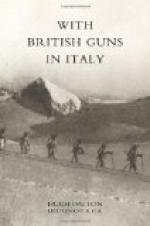The special military problems presented by warfare in such country were numerous and difficult. Our guns had to be dragged into position up a rough mountain track, which at some points was too narrow and at others too weak to allow the passage of a six-inch howitzer without much preliminary blasting and building up. Our first gun to go up took twenty-four hours of continuous labour between the time of starting up the track and the time of arriving in position, a distance of only about two miles of zig-zag. No tractor or other power engine could be used here. The only force available was that of men hauling on drag ropes, and a party of sixty Italian gunners reinforced our men.
What may be called the problems of pure gunnery were still more difficult. British Heavy guns had never fired under such conditions before and, for the benefit of such of my readers as may be practical Artillerymen, it may be interesting to remark that for one of our targets the angle of sight, properly so called, worked out at more than twenty degrees, while the map-range elevation was only about fifteen. The devising of an accurate formula for correction of elevation for a large “dislivello,” as the Italians shortly call it, which in English means a large “difference of level” between a gun and its target, is one of the most intricate problems of theoretical gunnery, or, for that matter, of theoretical mechanics, involving, among other factors, the various shapes and sizes of projectiles, their comparative steadiness during flight, the resistance of the air, and the effect of other atmospheric conditions and of the force of gravity.
There was a splendid opportunity for systematically testing various rival formulae in the Trentino, but it was allowed to slip. Among gunners, as among other classes, and especially among Regular Army gunners, the so-called practical man sees little value in scientific experiments, which do not produce large, obvious and quick returns. We fired many hundred rounds in the Trentino and I have no doubt that they were tolerably effective. But most of them were fired at night, with no observation possible, and we were often restricted in our registrations by daylight to four rounds a section per target, from which no really reliable conclusions could be drawn.[1]
[Footnote 1: We could get no help from Italian range tables, which were not merely for different guns and ammunition, but were drawn up on different principles from our own.]
* * * * *
We were billeted in the village of Tiarno di Sotto, where the Mayor under the Austrian regime, an Italian by race, was still carrying on his duties. “But I shall have to disappear, if the Austrians ever come back,” he said with a smile. It was a tremendous climb from our billets to get anywhere, the least tremendous being to our Battery position, straight up the nearest mountain side. A very active and energetic man could get up in a quarter of an hour. It used to take me twenty minutes. The weather, moreover, was hot, though considerably cooler than on the plains.




